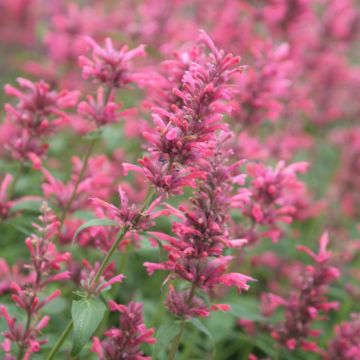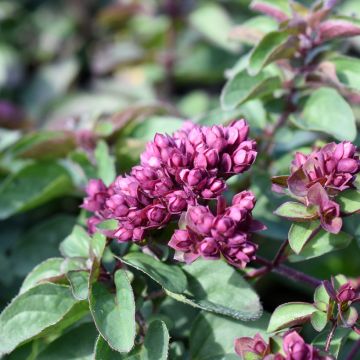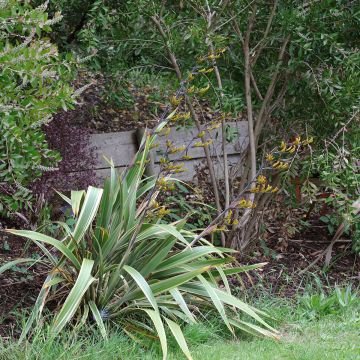

Foeniculum vulgare Giant Bronze - Bronze Fennel


Foeniculum vulgare Giant Bronze - Bronze Fennel


Foeniculum vulgare Giant Bronze - Bronze Fennel


Foeniculum vulgare Giant Bronze - Bronze Fennel


Foeniculum vulgare Giant Bronze - Bronze Fennel
Foeniculum vulgare Giant Bronze - Bronze Fennel
Foeniculum vulgare 'Giant Bronze' ou 'Purpureum'
Bronze Fennel
Hello, Received the 2 young plants well developed. Planting carried out in the following days and the recovery seems to be on track.
Brigitte D, 04/12/2025
Special offer!
Receive a €20 voucher for any order over €90 (excluding delivery costs, credit notes, and plastic-free options)!
1- Add your favorite plants to your cart.
2- Once you have reached €90, confirm your order (you can even choose the delivery date!).
3- As soon as your order is shipped, you will receive an email containing your voucher code, valid for 3 months (90 days).
Your voucher is unique and can only be used once, for any order with a minimum value of €20, excluding delivery costs.
Can be combined with other current offers, non-divisible and non-refundable.
Home or relay delivery (depending on size and destination)
Schedule delivery date,
and select date in basket
This plant carries a 12 months recovery warranty
More information
We guarantee the quality of our plants for a full growing cycle, and will replace at our expense any plant that fails to recover under normal climatic and planting conditions.
Would this plant suit my garden?
Set up your Plantfit profile →
Description
The Foeniculum vulgare 'Giant Bronze' elevates common fennel from the status of a vegetable and medicinal plant to that of a sumptuous perennial for the ornamental garden. This very beautiful variety develops an astonishing young foliage that is purple-coppery and gradually turns green-bronze as it grows. Its summer flowering, in umbels of ochre-yellow, forms a beautiful contrast with the foliage. Very airy and ethereal, it works wonders in sunny flowerbeds, bringing a lot of lightness without overshadowing its neighbors. It is remarkable in dahlia beds, with grasses or in a country setting.
Foeniculum vulgare (syn. Foeniculum officinale) belongs to the Apiaceae or umbelliferous family, it is a relative of carrot, celery and chervil, for example. This species, native to Turkey and Macedonia, is now naturalized in many regions with a Mediterranean climate, and of course throughout southern France where it is found along roadsides. It is a perennial herbaceous plant, generally deciduous in winter. It has excellent cold resistance, which allows it to be grown in all regions. Common fennel is a plant of sun and well-drained, even limestone, soils, adapted to summer drought. The cultivar 'Giant Bronze', larger than the type, also has remarkably coloured foliage.
The plant develops in spring from a large, fusiform and almost always bifid root, very long-lasting. Its habit is light, this fennel can easily exceed 1.50 m (5ft) in height and 60 cm (24in) in width under good growing conditions. The leaves, imbricated at the base, form a fleshy swelling improperly called a 'bulb': this is the part of the plant that is traditionally used in cooking. In 'Giant Bronze', the young shoots are of a remarkable dark copper color. As they unfold, they turn green, with bronze and copper reflections. The foliage is composed of strong, stiff stems bearing 'feathery' leaves, finely divided into thread-like segments. The flowering is triggered by the arrival of heat and/or drought: flowering occurs from June to August depending on the region. It takes the form of large flat umbels (10-15 cm (4-6in)) with 8 or 15 ray florets, loaded with small dark yellow flowers. This fragrant, nectar-bearing flowering is followed by the formation of numerous seeds that easily germinate here and there in the garden.
In the garden, this superb 'Giant Bronze' fennel will find its place in the sun in a well-drained, rocky or sandy soil, preferably at the back of flowerbeds due to its tall stature. Its astonishing ethereal foliage, bronze with copper reflections, allows for playing with contrasts of shapes and colors. It will bring a beautiful touch of lightness while enhancing neighboring plants. There are plenty of ideas for associations: with dahlias, grasses, Phlomis, echinaceas, Buenos Aires verbena, Caryopteris, columbines, garden irises, and many others. Giant Bronze fennel is just as edible as the classic variety, it is used in cooking for its aniseed flavor.
A vegetable and medicinal plant: all parts of common fennel are aromatic. They contain an essential oil used in aromatherapy and phytotherapy. In cooking, the leaves are used as a condiment, and the bulb is consumed as a vegetable.
Report an error about the product description
Foeniculum vulgare Giant Bronze - Bronze Fennel in pictures




Flowering
Foliage
Plant habit
Botanical data
Foeniculum
vulgare
'Giant Bronze' ou 'Purpureum'
Apiaceae
Bronze Fennel
Mediterranean
Other Herb perennials
View all →Planting and care
The common fennel is planted in spring or late summer depending on the climate. Choose a very sunny location. This perennial thrives in well-drained soils, even stony or sandy ones, fresh to dry in summer. It prefers neutral to calcareous soils, deep enough to accommodate its large root. Fertile soil will promote its development, although it can tolerate poorer soil. To plant your young plant, work your soil to a depth of 20 cm (8in) by crumbling the soil, in heavy soils, add a handful of gravel to the bottom of the hole. Position your plant, removed from its pot, by covering the top of the root ball with 3 cm (1in) of soil, fill in and water copiously to remove any air pockets. They establish easily in any good soil. Water regularly to help it establish. Once well established, fennel can do without watering in summer, in all regions. However, slightly moist soil will promote the growth of more abundant vegetation. We advise you to quickly remove faded flowers, on the one hand to avoid spontaneous sowing, and on the other hand to encourage the appearance of new leaves. Very resistant to cold, this fennel can still suffer from late frosts that can burn its young shoots. The few parasites that can affect fennel do not cause significant damage. This plant, very useful for biodiversity, feeds bees and hosts the superb caterpillar of the Swallowtail or Grand Porte kinds.
Planting period
Intended location
Care
-
, onOrder confirmed
Reply from on Promesse de fleurs
Similar products
Haven't found what you were looking for?
Hardiness is the lowest winter temperature a plant can endure without suffering serious damage or even dying. However, hardiness is affected by location (a sheltered area, such as a patio), protection (winter cover) and soil type (hardiness is improved by well-drained soil).

Photo Sharing Terms & Conditions
In order to encourage gardeners to interact and share their experiences, Promesse de fleurs offers various media enabling content to be uploaded onto its Site - in particular via the ‘Photo sharing’ module.
The User agrees to refrain from:
- Posting any content that is illegal, prejudicial, insulting, racist, inciteful to hatred, revisionist, contrary to public decency, that infringes on privacy or on the privacy rights of third parties, in particular the publicity rights of persons and goods, intellectual property rights, or the right to privacy.
- Submitting content on behalf of a third party;
- Impersonate the identity of a third party and/or publish any personal information about a third party;
In general, the User undertakes to refrain from any unethical behaviour.
All Content (in particular text, comments, files, images, photos, videos, creative works, etc.), which may be subject to property or intellectual property rights, image or other private rights, shall remain the property of the User, subject to the limited rights granted by the terms of the licence granted by Promesse de fleurs as stated below. Users are at liberty to publish or not to publish such Content on the Site, notably via the ‘Photo Sharing’ facility, and accept that this Content shall be made public and freely accessible, notably on the Internet.
Users further acknowledge, undertake to have ,and guarantee that they hold all necessary rights and permissions to publish such material on the Site, in particular with regard to the legislation in force pertaining to any privacy, property, intellectual property, image, or contractual rights, or rights of any other nature. By publishing such Content on the Site, Users acknowledge accepting full liability as publishers of the Content within the meaning of the law, and grant Promesse de fleurs, free of charge, an inclusive, worldwide licence for the said Content for the entire duration of its publication, including all reproduction, representation, up/downloading, displaying, performing, transmission, and storage rights.
Users also grant permission for their name to be linked to the Content and accept that this link may not always be made available.
By engaging in posting material, Users consent to their Content becoming automatically accessible on the Internet, in particular on other sites and/or blogs and/or web pages of the Promesse de fleurs site, including in particular social pages and the Promesse de fleurs catalogue.
Users may secure the removal of entrusted content free of charge by issuing a simple request via our contact form.
The flowering period indicated on our website applies to countries and regions located in USDA zone 8 (France, the United Kingdom, Ireland, the Netherlands, etc.)
It will vary according to where you live:
- In zones 9 to 10 (Italy, Spain, Greece, etc.), flowering will occur about 2 to 4 weeks earlier.
- In zones 6 to 7 (Germany, Poland, Slovenia, and lower mountainous regions), flowering will be delayed by 2 to 3 weeks.
- In zone 5 (Central Europe, Scandinavia), blooming will be delayed by 3 to 5 weeks.
In temperate climates, pruning of spring-flowering shrubs (forsythia, spireas, etc.) should be done just after flowering.
Pruning of summer-flowering shrubs (Indian Lilac, Perovskia, etc.) can be done in winter or spring.
In cold regions as well as with frost-sensitive plants, avoid pruning too early when severe frosts may still occur.
The planting period indicated on our website applies to countries and regions located in USDA zone 8 (France, United Kingdom, Ireland, Netherlands).
It will vary according to where you live:
- In Mediterranean zones (Marseille, Madrid, Milan, etc.), autumn and winter are the best planting periods.
- In continental zones (Strasbourg, Munich, Vienna, etc.), delay planting by 2 to 3 weeks in spring and bring it forward by 2 to 4 weeks in autumn.
- In mountainous regions (the Alps, Pyrenees, Carpathians, etc.), it is best to plant in late spring (May-June) or late summer (August-September).
The harvesting period indicated on our website applies to countries and regions in USDA zone 8 (France, England, Ireland, the Netherlands).
In colder areas (Scandinavia, Poland, Austria...) fruit and vegetable harvests are likely to be delayed by 3-4 weeks.
In warmer areas (Italy, Spain, Greece, etc.), harvesting will probably take place earlier, depending on weather conditions.
The sowing periods indicated on our website apply to countries and regions within USDA Zone 8 (France, UK, Ireland, Netherlands).
In colder areas (Scandinavia, Poland, Austria...), delay any outdoor sowing by 3-4 weeks, or sow under glass.
In warmer climes (Italy, Spain, Greece, etc.), bring outdoor sowing forward by a few weeks.



















































